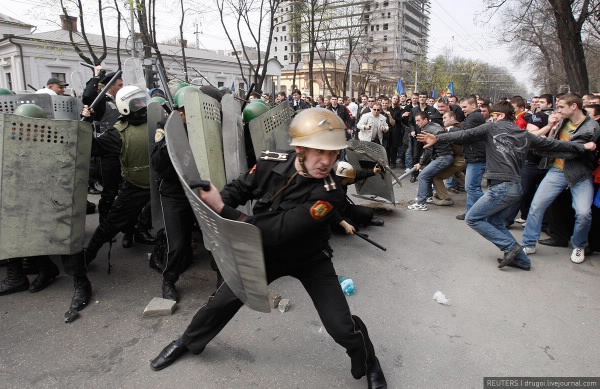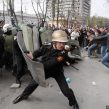
Violent Riots Devastate Moldovan Presidential and Parliament Buildings
Publication: Eurasia Daily Monitor Volume: 6 Issue: 68
By:

Crowds of young rioters overran, ransacked, and set on fire the presidential and parliament buildings in Moldova’s capital Chisinau on April 7. This outbreak may serve to embolden radical groups in Georgia on the eve of their April 9 demonstration, the declared goal of which is to force a change of government in Tbilisi.
Political violence was deemed unthinkable in Moldova until now. The nominally Communist Party won the parliamentary elections for the third consecutive time on April 5 -this time with 49.5 percent of the votes cast- in a balloting assessed positively overall by Western observers and international organizations (EDM, April 7). The opposition’s three nominally liberal parties seek to force the cancelation of the election results and called for public protests, which they seemed to expect to run peacefully. The opposition leaders, however, quickly lost control of the events they had helped trigger. Their resort to incendiary rhetoric was followed by the incendiary assault in the literal sense against the main state institutions. Equally inept, the authorities were blindsided and lost control of the situation.
The protests began peacefully in the evening of April 6 with a "rally of mourning" over the Communist Party’s electoral success. Called via mobile phone and SMS messages by several obscure NGOs (the known and reputable ones were not involved), that rally as well as a follow-up one next morning were authorized by City Hall in accordance with the law, but degenerated into chaos by mid-day on April 7. The police, clearly intimidated, looked on, allowing the political protests at this point to descend into violent anarchy.
Up to 10,000 demonstrators, mostly in their twenties and teens, surrounded the presidency and parliament buildings (situated across from each other on the main avenue) and besieged both institutions for several hours. A violent core of up to one thousand forced their way inside in broad daylight, set fire to several floors in both buildings, carted out massive amounts of furniture and office equipment, and used some of these to light bonfires outside. The buildings and bonfires burned and smoldered through the night of April 7 to 8.
The police was present in small numbers and under strict orders from President Vladimir Voronin to refrain from using force in response to the violence. After initial attempts to use water hoses and sound petards to hold off the crowds, the police turned essentially into bystanders. Hopelessly outnumbered, some policemen were beaten up; others were rewarded with flowers for not responding with force; and ultimately the police abandoned the scene altogether by mid-afternoon. Rioters disabled three police vehicles and two fire-brigade vehicles that had attempted to intervene (Infotag, April 7). It was only by 2:00 am on April 8, after most rioters had gone home, that the authorities returned to the scene and re-entered the devastated buildings.
Opposition leaders insist that the violence broke out "spontaneously." This seems true to some extent, but some elements of organization could also be seen. Stones and rocks were supplied to the crowd in great abundance, some of it carried by rioters with rucksacks. This "ammunition" proved decisive in holding the police at bay and breaking the doors and windows of the parliament and presidential buildings for the crowds to enter. At some moments, phalanxes of stone-throwers stepped out of the crowd, launched their projectiles and stepped back again.
The crowd was too chaotic to listen to political leaders or develop its own leadership, and too heterogeneous to voice a set of political demands. While many joined in hopes of forcing the cancellation of the parliamentary elections, others used the opportunity to call for Moldova’s unification with Romania. This element within the crowd hoisted Romanian flags and pinned a large-size contour map of Greater Romania (inscribed, Romania My Fatherland) on the presidential building’s entrance. Slogans at the rallies on April 6 and 7 included chants about "Bessarabia" uniting with Romania. This was not a dominant note, but it did touch a raw nerve in the authorities. Anti-communist slogans (variations on "down with communism") were ubiquitous. European symbols were very rare in the demonstration and the European election observers’ generally positive assessment of the elections was completely ignored by the protesters.
Economic and social demands were conspicuously absent. By contrast, the element of what French sociologists term "emeutes ludiques" (rioting for entertainment) was omnipresent. The crowd’s other common denominator was its young age. While many participants were university students and secondary-school pupils, however, many others were working-class or unemployed youths in those same age brackets.
The authorities’ initial reaction was one of shock. Voronin and his top adviser, Marc Tcaciuc, made statements describing the assault as a "putsch," naming the three main opposition leaders as instigators, and alluding to involvement from Romania in the organization the protests. By the late evening, however, Voronin and the chairman of the outgoing parliament, Marian Lupu, invited the opposition leaders’ trio -Liberal Party’s Dorin Chirtoaca, Liberal-Democrat Party’s Vlad Filat, and Our Moldova’s Serafim Urecheanu- for talks and appeared with them on television in a joint format.
The three opposition leaders distanced themselves from the violence, claiming that they had tried unsuccessfully to reason with the protesters and were not heeded. But they did announce their intention to continue calling for political protests until the opposition’s demands are met.
The opposition trio’s main demand is non-recognition of the parliamentary election’s results. One moment they demand outright cancelation of the elections and holding of new elections, the next moment to demand a recount of the votes in this election. Voronin and Lupu have agreed that recounts be held wherever the opposition shows evidence of fraud to the central and local election commissions, as the law provides. The opposition trio has not shown any evidence at all thus far, but is vowing to collect and submit it. The three parties have obtained a total of 40 parliamentary seats, the Communist Party 61 seats in the newly elected parliament (Moldpres, Moldovan TV Channel One, Infotag, ProTV, April 7, 8).




